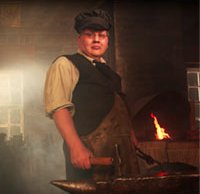Adding atmosphere: How to create dramatic light beams in-camera and in Photoshop
posted Saturday, July 23, 2016 at 6:59 AM EST

While it is possible to create shafts of light for your images in Photoshop -- as we will see at the end of the article -- it never hurts to know how to do something in-camera. In fact, oftentimes you will save yourself trouble and end up with more natural-looking results by limiting the amount of post-processing you do.
Photographer Jay P. Morgan is regularly coming up with cool ways to add a distinct twist to his portraits and this latest video is no different. When creating shafts of light in camera, there are multiple things that you have to consider. Your image (or video) needs to have atmosphere. For a shaft of light to appear, it needs to have something to reflect off, such as fog, dust or smoke. You can create atmosphere with a hazer or smoke machine. Morgan recommends Rosco for your smoke machine needs.
Another important aspect of creating shafts of light is that your light needs to be at an angle relative to your camera, such as a 45-degree angle. Continuous light sources work best for this as you're able to focus the beam of light better than you can with a strobe. You can add different modifiers to your strobes to help, but continuous lighting is still better-suited for this. To see the rest of the considerations when creating in-camera shafts of light, see the video below.
What if you have an image that you want to add shafts of light to or you're in a situation in which you simply can't use a smoke machine and lighting, such as when photographing an expansive landscape? Fortunately, you can add beams of light in Photoshop. You can even create your own custom brush to use whenever you want to give your images more dramatic lighting.
Phlearn has created an excellent tutorial for creating beams of light in Photoshop, which you can see below. You can also check out this Phlearn tutorial for creating dust in Photoshop if you're looking to add another atmospheric touch to your images.
(Seen via DIY Photography)